Papers by Francesca Bianco
Active Volcanoes of the World, 2022
Bollettino Di Geofisica Teorica Ed Applicata, 2010
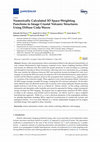
Geosciences
Seismic coda measurements retrieve parameters linked to the physical characteristics of rock volu... more Seismic coda measurements retrieve parameters linked to the physical characteristics of rock volumes illuminated by high frequency scattered waves. Space weighting functions (SWF) and kernels are different tools that model the spatial sensitivity of coda envelopes to scattering and absorption anomalies in these rock matrices, allowing coda-wave attenuation (Q coda) imaging. This note clarifies the difference between SWF and sensitivity kernels developed for coda wave imaging. It extends the SWF previously developed in 2D to the third dimension by using radiative transfer and the diffusion equation, based on the assumption that variations of Q coda depend solely on variations of the extinction length. When applied to active data (Deception Island, Antarctica), 3D SWF images strongly resemble 2D images, making this 3D extension redundant. On the other hand, diffusion does not efficiently model coda waveforms when using earthquake datasets spanning depths between 0 and 20 km, such as at Mount St. Helens volcano. In this setting, scattering attenuation and absorption suffer tradeoffs and cannot be separated by fitting a single seismogram energy envelope for SWF imaging. We propose that an approximate analytical 3D SWF, similar in shape to the common coda kernels used in literature, can still be used in a space weighted back-projection approach. While Q coda is not a physical parameter of the propagation medium, its spatially-dependent modeling allows improved reconstruction of crustal-scale tectonic and geological features. It is even more efficient as a velocity independent imaging tool for magma and fluid storage when applied to deep volcanism.
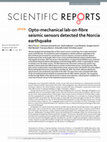
Scientific reports, Jan 27, 2018
We have designed and developed lab-on-fibre seismic sensors containing a micro-opto-mechanical ca... more We have designed and developed lab-on-fibre seismic sensors containing a micro-opto-mechanical cavity on the fibre tip. The mechanical cavity is designed as a double cantilever suspended on the fibre end facet and connected to a proof mass to tune its response. Ground acceleration leads to displacement of the cavity length, which in turn can be remotely detected using an interferometric interrogation technique. After the sensors characterization, an experimental validation was conducted at the Italian National Institute of Geophysics and Volcanology (INGV), which is responsible for seismic surveillance over the Italian country. The fabricated sensors have been continuously used for long periods to demonstrate their effectiveness as seismic accelerometer sensors. During the tests, fibre optic seismic accelerometers clearly detected the seismic sequence that culminated in the severe Mw6.5 Norcia earthquake that struck central Italy on October 30, 2016. The seismic data provided by the...
Annals of Geophysics, 1996
Geophysical Journal International, 2005
We investigated the intrinsic dissipation and scattering properties of the lithosphere under the ... more We investigated the intrinsic dissipation and scattering properties of the lithosphere under the Friuli region (northeastern Italy) using two hypotheses: (i) a uniform earth model and (ii) two 'reasonable' non-uniform, layered crustal models. For case (i) we measured the coda Q, and used the multiple-lapse time window analysis (MLTWA) technique to obtain separate estimates of intrinsic absorption and scattering attenuation. Results for the uniform earth model show that the lithosphere in northeastern Italy is characterized by a low-scattering attenuation (small scattering Q-inverse, Q −1 s), and by a relatively high intrinsic attenuation (high intrinsic Q-inverse, Q −1 i). A comparison between the investigated region and other areas around the world shows that both Q −1 i 130
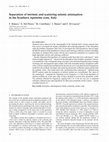
Geophysical Journal International, 2002
Scattered waves observed at the seismographs of the National Italy's seismic network have be... more Scattered waves observed at the seismographs of the National Italy's seismic network have been used to investigate the intrinsic dissipation and scattering properties of the lithosphere under the Southern Apennines, Italy. First, we investigate the coda-Q properties, then we apply the MLTW analysis in the hypothesis of velocity and scattering coefficient constant with depth, and finally we interpret these results with the aid of numerical simulations in a medium with depth dependent velocity and scattering coefficient.Results obtained in the hypothesis of a uniform model show that a low scattering-Q−1 and a relatively higher intrinsic-Q−1 characterize the lithosphere of the Southern Apennines. Numerical simulations of the seismogram energy envelopes were performed hypothesizing a strongly scattering crust and trasparent upper mantle, both with reasonable intrinsic dissipation coefficients. In these symplifying assumptions the theoretical curves calculated for the homogeneous mo...
Geophysical Journal International, 2009
Stress can undergo rapid temporal changes in volcanic environments, and this is particularly true... more Stress can undergo rapid temporal changes in volcanic environments, and this is particularly true during eruptions. We use two independent methods, coda wave interferometry (CWI) and shear wave splitting (SWS) analysis to track stress related wave propagation effects during the waning phase of the 2002 NE fissure eruption at Mt Etna. CWI is used to estimate temporal changes in seismic wave velocity, while SWS is employed to monitor changes in elastic anisotropy. We analyse seismic doublets, detecting temporal changes both in wave velocities and anisotropy, consistent with observed eruptive activity. In particular, syn-eruptive wave propagation changes indicate a depressurization of the system, heralding the termination of the eruption, which occurs three days later.
Geophysical Journal International, 2016
Geophys J Int, 2006
The time delays and polarizations of shear wave splitting above small earthquakes show variations... more The time delays and polarizations of shear wave splitting above small earthquakes show variations before the 2001 July 17-August 9 2001 flank eruption on Mt Etna, Sicily. Normalized time delays, measured by singular value decomposition, show a systematic increase starting several days before the onset of the eruption. On several occasions before the eruption, the polarization directions of the shear waves at Station MNT, closest to the eruption, show 90°-flips where the faster and slower split shear waves exchange polarizations. The last 90°-flip being 5 days before the onset of the eruption. The time delays also exhibit a sudden decrease shortly before the start of the eruption suggesting the possible occurrence of a `relaxation' phenomena, due to crack coalescence. This behaviour has many similarities to that observed before a number of earthquakes elsewhere.
Computers Geosciences, Oct 1, 2010
The MATHCAD 2000 professional code to perform the Multiple Lapse Time Analysis (MLTWA) has been r... more The MATHCAD 2000 professional code to perform the Multiple Lapse Time Analysis (MLTWA) has been revised and rewritten in MATHEMATICA 7. The new code contains two new procedures to find the minimum of the misfit function between observation and model and ...

Passive, high resolution attenuation tomography is used to image the geological structure in the ... more Passive, high resolution attenuation tomography is used to image the geological structure in the first upper 4 km of shallow crust beneath the Campanian Plain. Images were produced by two separate attenuation tomography studies of the main volcanic regions of the Campanian Plain, Southern Italy, Mt. Vesuvius volcano and Campi Flegrei caldera. The three-dimensional S wave attenuation tomography of Mt. Vesuvius has been obtained with multiple measurements of coda-normalized S-wave spectra of local small magnitude earthquakes. P-wave attenuation tomography was performed using classical spectral methods. The images were obtained inverting the spectral data with a multiple resolution approach expressively designed for attenuation tomography. This allowed to obtain a robust attenuation image of the volumes under the central cone at a maximum resolution of 300 m. The same approach was applied to a data set recorded in the Campi Flegrei area during the 1982-1984 seismic crisis. Inversion ensures a minimum cell size resolution of 500 meters in the zones with sufficient ray coverage, and 1000 meters outside these zones. The study of the resolution matrix as well as the synthetic tests guarantee an optimal reproduction of the input anomalies in the center of the caldera, between 0 and 3.5 km in depth. Results allowed an unprecedented view of several features of the medium, like the residual part of solidified magma from the last eruption, under the central cone of Mt. Vesuvius, and the feeding systems and top of the carbonate basement, 3 km depth below both volcanic areas. Vertical Q contrast image important fault zones, such as the La Starza fault, as well as high attenuation structures that correspond to gas or fluid reservoirs, and reveal the upper part of gas bearing conduits connecting these high attenuation volumes with the magma sill revealed at about 7 km in depth by passive travel-time tomography under the whole Campanian Plain.

Journal of Volcanology and Geothermal Research, 2003
The occurrence of a seismic series in Deception Island volcano (Antarctica), composed of hundreds... more The occurrence of a seismic series in Deception Island volcano (Antarctica), composed of hundreds of local volcano-tectonic earthquakes, has permitted us to study the seismic attenuation of such a volcanic environment in the short-distance and high-frequency range. This study has been performed using P-waves, S-waves and coda-waves and applying different, frequency dependent and independent, techniques. The methods used for this analysis have been: spectral and broadening-of-the-pulse, for direct P- and S-waves, coda normalization for S-waves, and single back-scattering model for coda-waves. The results show that, in general, Q values are significantly smaller for the entire frequency range used (6-30 Hz) than those found in other volcanic and tectonic areas. The attenuation for P-waves is greater than for S-waves in the frequency independent methods, with a Q β/ QP ratio that ranges between 1.9 and 3.2. Comparing the Q-factor obtained for S-waves we have observed clear differences as a function of the method used; the coda normalization method has supplied significantly higher Q values ( Q d) than the other two methods ( Q β). We have interpreted this discrepancy as an effect of the methods: coda normalization and single back-scattering methods eliminate the contribution of the near-surface attenuation in their Q values. Comparing both Q β and Q d we have estimated the near-surface attenuation under the recording site, named Q κ. On the other hand, we have observed that Q d has anomalous frequency dependence, with a minimum value at 21 Hz. This pattern is interpreted as an effect of strong scattering of the seismic waves in the source area of the earthquakes. Q c values depend clearly with frequency and lapse time and the lapse time dependence could be interpreted as a depth dependence of the seismic attenuation in Deception Island volcano, Antarctica. The obtained Q values have allowed us to separate the contribution of intrinsic and scattering attenuation, deriving that the scattering attenuation is predominant over the intrinsic effects. Finally, in order to investigate how the heterogeneous medium of the volcanic island could produce other effects, we have checked whether it produces polarization of the shear-waves. The preliminary results of the polarization direction indicate a main E-W strain direction. All these evidences reveal the strongly heterogeneous structure of Deception Island volcano.
In copertina Risposta teorica dell'array VAS calcolata per quattro diverse frequenze (particolare)
We study the time changes of (a) b-value of Gutenbergh-Richter distribution, (b) inverse Q-coda a... more We study the time changes of (a) b-value of Gutenbergh-Richter distribution, (b) inverse Q-coda and (c) time delay Td between qS1 and qS2 phases (from Shear wave splitting measurements) for low-magnitude Volcano-tectonic (VT) earthquakes of Mt Vesuvius, Italy. We used for (a) the seismic catalogue of Mt Vesuvius seismicity starting from January 1994; for (b) a selected (on the base

Bulletin of Earthquake Engineering, 2015
ABSTRACT Ground motion produced by low magnitude earthquakes can be used to predict peak values i... more ABSTRACT Ground motion produced by low magnitude earthquakes can be used to predict peak values in high seismic risk areas where large earthquakes data are not available. In the present work 20 local earthquakes (MD∈[−0.3, 2.2]) occurred in the Campi Flegrei caldera during the last decade were analyzed. We followed this strategy: empirical relations were used to calibrate synthetic modeling, accounting for the source features and wave propagation effects. Once the source and path parameters of ground motion simulation were obtained from the reference data set, we extrapolated scenarios for stronger earthquakes for which real data are not available. The procedure is structured in two steps: (1) evaluation of ground motion prediction equation for Campi Flegrei area and assessment of input parameters for the source, path and site effects in order to use the finite fault stochastic approach (EXSIM code); (2) simulation of two moderate-to-large earthquake scenarios for which only historical data or partial information are available (Mw4.2 and Mw5.4). The results show that the investigated area is characterized by high attenuation of peak amplitude and not negligible site effects. The stochastic approach has revealed a good tool to calibrate source, path and site parameters on small earthquakes and to generate large earthquake scenario. The investigated magnitude range represents a lower limit to apply the stochastic method as a calibration tool, due to the small size of involved faults (fault length around 200/300 m).
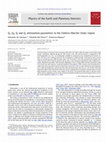
Physics of The Earth and Planetary Interiors
he attenuation of coda and S waves has been inferred for the Umbria-Marche region (central Italy)... more he attenuation of coda and S waves has been inferred for the Umbria-Marche region (central Italy) using seismic waveforms collected during the 1997 seismic crisis. The selected dataset is composed of 343 small magnitude (1.4 <ML<4.2) earthquakes recorded at a temporary array composed of 23 seismic stations. The Sato (1977) method, based on the assumption of single isotropic scattering has been used to infer Qc, considering three different lapse times (20, 30 and 40 s). The coda normalization method (Aki, 1980) has been used to infer Q. Both Qc and Qshow a clear frequency dependence with a different frequency dependent parameter. The frequency dependence of Qc is comparable with that previously found in the same area and around it. Using the method of Wennerberg (1993), intrinsic and scattering attenuation have been separated. Intrinsic attenuation is found to be close to coda attenuation and dominates over scattering dissipation. Coda Q increases with increasing lapse time ...
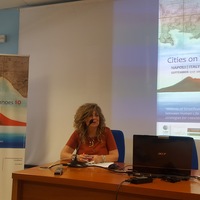










Uploads
Papers by Francesca Bianco